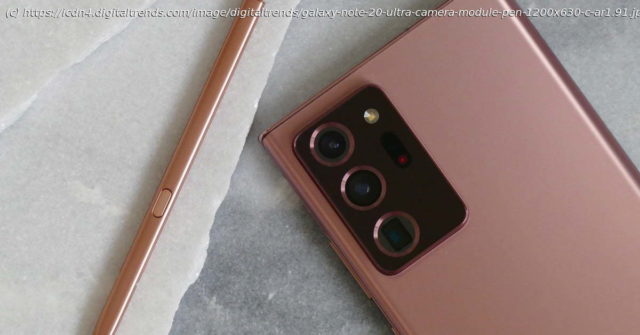It’s go big, or go home when it comes to Samsung’s Galaxy Note series, and the new Note 20 Ultra is the biggest, most feature-packed version of the phone yet.
Go big or go home. That’s always been Samsung’s motto with the Galaxy Note series, and the Galaxy Note 20 Ultra is its biggest effort yet. The screen is even larger than last year’s Galaxy Note 10 Plus, and there’s also more power, more features, and more technology — all aimed at improving productivity and increasing its media capabilities. Your wallet had better be bigger too, as the Galaxy Note 20 Ultra starts at $1,299. Samsung’s approach to outdoing the competition is simple: Beat them into submission by offering everything a phone buyer could possibly want, in a phone that will last for years. Pushing the boundaries of what’s acceptable in terms of device size and price, the Galaxy Note 20 Ultra even outdoes the Galaxy Note 10 Plus — a phone we called the best Android phone of 2019. If the design of the Galaxy Note 10 Plus was a little ordinary, the Note 20 Ultra is anything but. That’s especially evident in the new Mystic Bronze color of the devices in the photos. The camera module is massive, protrudes by several millimeters, and dominates the back of the phone. It’s very different from the dainty module on the Note 10 Plus, and even more in your face than the Galaxy S20 Ultra’s module. The glass covering has a strong, bright sheen in different lighting conditions. The Mystic Bronze itself falls somewhere between gold and pink, and is classy rather than gaudy. The matte finish has plenty of grip and resists fingerprints, but the glass over the camera module doesn’t, and it often needed a good wipe before taking photos. Take away the monster camera module and the Note 20 Ultra shares the same basic shape as the Note 10 Plus, where the curved sides taper down to a point while remaining perfectly comfortable to grip. Samsung has swapped the buttons over to the right-hand side of the phone and, for me, as a right-handed person, it’s far more natural than the Note 10 Plus, where the buttons were on the left. In the new layout, the S Pen stylus is stored on the left side of the phone, the top and bottom of the phone are flat, and there’s a single hole-punch selfie camera in the screen. I have average-sized hands, and the Note 20 Ultra is right on the edge of being too big and too heavy at 77.2mm (3.04 inches) wide,8.1mm (0.32 inches) thick, and 208 grams (0.46 pounds). It is well-balanced but can feel top-heavy when you’re using it while laying down. It’s also frustrating to juggle it with one hand when you just want to check a notification or take a selfie. It’s these quick tasks that can make using the massive Note 20 Ultra a bit of a chore, and sometimes I’d long for a smaller, more manageable device. I felt this less with the 196-gram,7.9mm-thick Note 10 Plus. The Note 20 Ultra is a whopper of a phone and requires commitment to carry and use every day. The reward is worth the effort, but if you’re graduating from a smaller phone (which is just about every other phone available), be prepared for a period of adjustment as you get used to it. This applies even if you’re coming from the Note 10 Plus, which feels surprisingly lithe and usable compared with the Note 20 Ultra. I always appreciate an extr- large screen, but the massive chassis required to accommodate it can feel like a step too far. A 6.9-inch Dynamic AMOLED screen with a 1,440 x 3,088 pixel resolution, a variable 120Hz refresh rate, and even HDR10+ support catches your attention. The Note 20 Ultra is the first Samsung phone to use Samsung Display’s variable refresh rate technology, which adapts depending on what you’re doing on your phone. For example, it’ll use 120Hz when playing games that support it, or switch to 60Hz for movies, or even 10Hz for still photos. The aim is to be more power efficient. This adaptive refresh rate is set as standard, but it’s possible to force it to permanently use a 60Hz refresh rate. Similarly, the resolution by default is 2,316 x 1,080, and it must be manually changed to 3,088 x 1,440 — to enjoy this, however, you have to use a 60Hz refresh rate. It’s lovely to look at, just like the majority of Samsung phones. I used it in the default setting most of the time and had no complaints about the quality or sharpness. Scrolling through some apps is not as smooth as I’d expected. I experienced some jerkiness in Twitter and in parts of Chrome too, which may have more to do with Android than the screen. There are minimal bezels at the top and the bottom of the display, and it gently curves down the sides to give a large viewing area. Even the hole-punch for the selfie camera is tiny. Watching Woyshnis Media’s YouTube video featuring the Lamborghini Huracán Perfomante and Mercedes Benz AMG GTS is a great demonstration of how fantastic the screen is, and also how a display tweak called the Video Enhancer works. The green Lamborghini pops off the screen with the mode active, while the darker AMG remains subdued until you get close, and the colorful flake in the paint becomes noticeable. This neat balance isn’t common in display-enhancing modes, and meant I didn’t mind leaving the Video Enhancer on most of the time. I put the Galaxy Note 20 Ultra alongside the equally stunning Sony Xperia 1 II to test video, and the results are surprising. The Note 20 Ultra doesn’t play 4K YouTube video like the Sony phone, but watching Carfection’s Porsche Taycan review, it hardly shows. The Note 20 Ultra’s screen is vibrant with color, yet still delivers crisp whites, and the large size really does return a beautiful viewing experience. There are stereo speakers on the Galaxy Note 20 Ultra, one set at the top of the screen for calls, and another on the bottom of the phone. The sound is full, with plenty of midrange and clear highs. As you’d expect, there’s little low-end bass. It’s loud though, and while the sound gets pretty bright, there’s no distortion at maximum volume. The Note 20 Ultra also has Dolby Atmos support. The screen and media experience on the Galaxy Note 20 Ultra is superb, but it’s marred by problematic palm and finger rejection at the edges of the screen. I’m using a prerelease phone, so this may be cured in a software update ahead of it going on sale. But as it stands now, it’s a pain. Because of it, miscellaneous apps open accidentally while others get closed, I’ve sent voice messages by accident in WhatsApp, and many buttons on the sides of the screen won’t work until you adjust your grip. It’s very frustrating, but I’m hoping an update will arrive to cure it. The camera is one of the major upgrades the Note 20 Ultra boasts over the Note 10 Plus.






